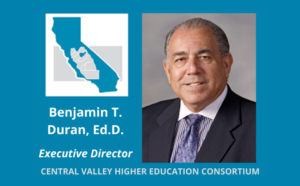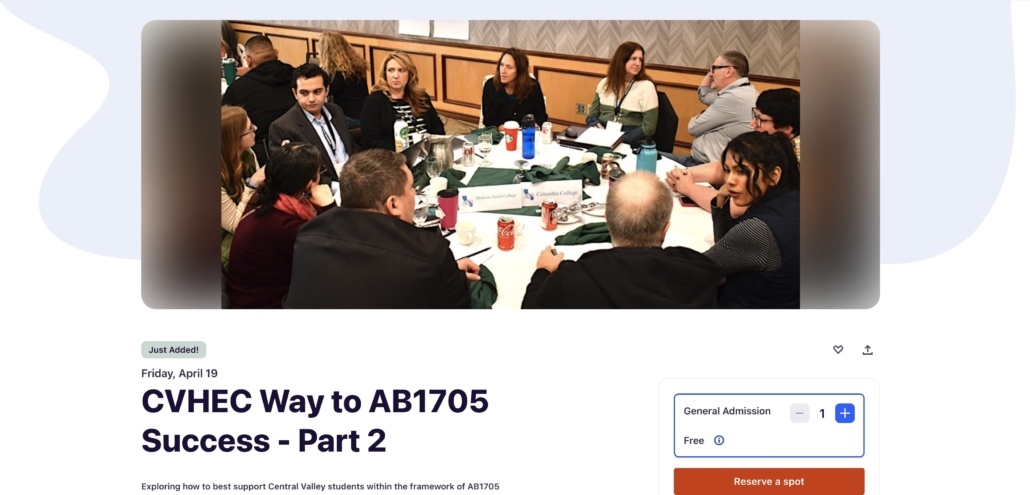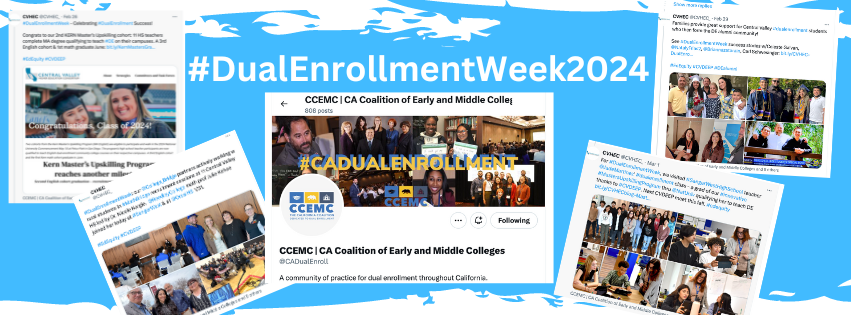This month’s “What The CV-HEC Is Happening” Blog takes a unique look at an unprecedented wave of leadership at five major Kern County education institutions: California State University, Bakersfield; Kern […]
Secondary education voices invited to join discussion
Discussions to improve calculus pathways for STEM students amidst a pending deadline this summer continues with the third “Central Valley Way to AB1705 Success” Convening set for Friday, April 19 in Fresno that will also bring more secondary education voices to the table and a review of guidance issued by the California Community College Chancellors Office last month.
Registration is now open for the event in Fresno presented by the Central Valley Higher Education Consortium Math Task Force with the Charles A. Dana Center (University of Texas at Austin) from 9 a.m. to 3 p.m. at the DoubleTree by Hilton Hotel Fresno Convention Center, the site of two previous in-person convenings last fall and in January.
The event will re-convene community college math educators, administrators and institutional researchers working since the fall towards compliance with the final stage of AB1705: validation of equitable placement, support and completion practices for STEM programs.
Signed into law by Gov. Newsom in September 2022, AB 1705 is an amendment to the landmark legislation AB 705 (Irwin, 2017) which transformed placement and developmental education in the California Community Colleges. AB1705 supports full and comprehensive implementation by, among other requirements, specifying that colleges must demonstrate the benefit of transfer-level math preparatory courses for STEM Calculus 1 based on the following conditions:
- The student is highly unlikely to succeed in the first STEM calculus course without the additional transfer-level preparation.
- The enrollment will improve the student’s probability of completing the first STEM calculus course.
- The enrollment will improve the student’s persistence to and completion of the second calculus course in the STEM program, if a second calculus course is required.
From now until July 1, colleges have the opportunity to validate that their preparatory courses meet the aforementioned AB 1705 standards.
Since passage, the state’s community colleges have worked towards compliance of various aspects of AB1705 including 19 Central Valley community college members of CVHEC through representatives serving on the consortium’s Math Task Force consisting of math faculty and administrators.
The task force has held several virtual and in-person work sessions since October designed to collaborate in unity for compliance. At the last convening Jan. 26, more than 82 math and administrative representatives from the community colleges — including several campus research professionals — and one high school principal met with the task force to explore five strands of curriculum planning:
- Validating Prerequisites;
- Designing Precalculus for 2025;
- Math Support Outside and Inside the Classroom;
- Building an AB 1705 Campus Team; and
- Guided Self-Placement.
Since the Jan. 26 meeting, the strand leads have been preparing summaries of their breakout discussions held that day, said Dr. John Spevak, CVHEC regional coordinator who oversees the consortium’s Math Task Force.
Member college teams are also preparing summaries of the tentative plans they developed in the afternoon breakout sessions for oral reports. Additionally, the workgroups have been meeting and will report out on their progress in April regarding the strands.
A good portion of the April 19 meeting will be devoted to the data collection underway by CVHEC community college research professionals related to student success in math, part of the valleywide Data Collection Project under development by the consortium, said Spevak, who will again co-facilitate the April event with Dana Center colleague Dr. Tammi Perez-Rice.
Secondary ed voices
This next convening will also include representatives of K-12 school districts, including several high school principals who have already worked with CVHEC through the Central Valley Math Bridge Program.
“It’s important to bring into the conversation high school leaders and our colleagues who care as much about the future math success of students as community college math educators do,” said Dr. Benjamín Durán, CVHEC executive director.
That conversation was begun at the January convening of community college math professors and administrators when Marlena Celaya, principal of Orosi High School and former high school math teacher, told the group that Central Valley high school educators would very much like to participate in future discussions about math success for Central Valley students.
Spevak said this development will also foster additional learning about the high school math landscape as it pertains to college readiness.
Any Central Valley secondary education officials interested in attending the April 19 convening are welcome, he added.
CCC ‘validation memo’
Also up for discussion will be a Feb. 27 validation memorandum by the California Community College Chancellors Office entitled AB 1705 Validation of Equitable Placement, Support and Completion Practices for STEM Programs.
The Chancellor’s Office also presented a webinar March 4 to further discuss the details of this guidance and address questions.
The Dana Center and CVHEC teams are presently reviewing the CCC memo to provide analysis that will help guide the Math Task Force’s five strands committees and will be presenting its memo assessment in the coming weeks, said Joan Zoellner, M.A., who is the lead for the Dana Center’s Launch Years Initiative;
In a preliminary review of the memo, Zoellner noted that while the CCC memo provides direction on the validation process for transfer level math placement and enrollment practices for STEM programs, it indicates that no more than one transfer-level prerequisite shall be offered prior to calculus.
“The options for that prerequisite course are limited by the memo and validation options as well,” Zoellner said.
She recommended that consortium community colleges review the chancellor’s office memo and some of the findings presented to determine how it affects their respective campus.
“If possible, work with your IR department to confirm those numbers and results prior to the April 19 convening,” Zoellner advises.
For more info: centralvalleyhec@gmail.com
For media inquiries: Tom Uribes – cvheccommunications@mail.fresnostate.edu (or text 559.348.3278).
See also:
- CCCCO Memo Feb. 27, 2024: AB 1705 Validation of Equitable Placement, Support and Completion Practices for STEM Programs
- CVHEC Math Task Force
- What is AB 705 and AB 1705?
- WHAT THE CV-HEC IS HAPPENING BLOG (October 2022): AB 1705 – What Does It Do?
- CCC Memos and Resources
- https://bit.ly/MTFconveneKSEE24
- Valley’s math ed experts unite to address AB 1705 challenge for student success
- The CVHEC Way to Math Success — Implementing AB1705
- Math Task Force begins discussion of AB1705 implementation – Nov. 17 next
CVHEC Math Task Force meets in-person Oct. 13 for AB 1705 follow-up - NEWS RELEASE – CVHEC Math Task Force: Impactful legislation (AB 1705) Convenings Oct. 6 & 13
- CVHEC Website Feature: Math Task Force Page
CVHEC joins dual enrollment partners
in statewide digital campaign
The Central Valley Higher Education Consortium participated in the Digital Dual Enrollment Week social media campaign conducted statewide Feb 26-March 1 by the California Alliance of Dual Enrollment Partnerships (CADEP).
The weeklong campaign followed the 2nd Annual California Dual Enrollment Equity Conference held Feb. 20-23 in Long Beach presented by CADEP, Career Ladders Project, and The Education Trust–West with fiscal agent the Foundation for Los Angeles Community Colleges.
The California Alliance of Dual Enrollment Partnerships is an affiliated chapter of the National Alliance of Concurrent Enrollment Partnerships (NACEP), is a unified coalition committed to the advancement of equity, student success and quality in dual enrollment programs in California.
Its vision is to unite individuals, state agencies and organizations committed to dual enrollment in California to promote and advance quality dual enrollment programming across the state.
For the social media campaign, dual enrollment partners were asked to promote a specific theme each day:
MONDAY – Feb. 26: Celebrate Dual Enrollment Success
TUESDAY – Feb. 27: Dual Enrollment Myth Busting
WEDNESDAY – Feb. 28: Dual Enrollment is an Equity Strategy – Widening the Front Door to College
THURSDAY – Feb. 29: Families, Communities and Dual Enrollment
FRIDAY – March 1: Innovations in Dual Enrollment
“We were able to incorporate several of our projects and dual enrolment student interactions over the past few years into the social media campaign,” said Tom Uribes, CVHEC communications/media coordinator.
CVHEC featured its Central Valley Dual Enrollment for Equity and Prosperity (CVDEEP) Projects and outcomes: Master’s Upskilling Project recent graduates; the consortium’s dual enrollment video; the Math Bridge project in collaboration with College Bridge; students who participated in the video and at CVHEC convenings sharing their success stories as well as their families; and visiting the dual enrollment classroom of Jade Martinez, a Sanger West High School English teacher who completed the innovative Master’s Upskilling Project that qualified her to teach the community college courses at her high school.
CVDEEP is now looking ahead to its annual convening that will be held in the fall this year. Details will be forthcoming in future CVHEC newsletters.
For more info on CVHEC Dual enrollment work please visit. https://cvhec.org/dual-enrollment-in-the-central-valley/
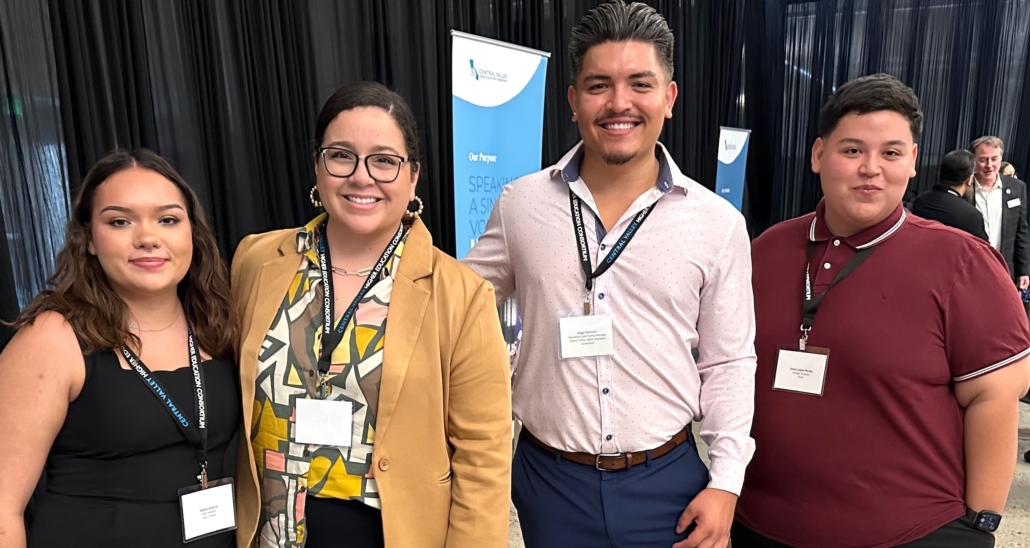
Priscila Villanueva at the 2023 CVHEC Summit with Angel Ramirez and two student panelists, Hailee Guerra (left) and Jesús López Nuñez (right).
This issue brings another melancholy moment as we bid farewell to a key star of the Central Valley Higher Education Consortium team, Priscila Villanueva, our administrative coordinator since 2018.
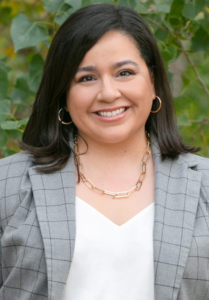 Priscila will start a new position as community associate for Equitable Bank Standards, Beneficial State Foundation supporting community engagement for the Equitable Bank Standards initiative.
Priscila will start a new position as community associate for Equitable Bank Standards, Beneficial State Foundation supporting community engagement for the Equitable Bank Standards initiative.
She has been instrumental in CVHEC’s mission with a focus on increasing educational equity in the Central San Joaquin Valley, said Dr. Benjamín Durán, CVHEC executive director.
“Priscila became an important part of our CVHEC family and will be dearly missed,” Durán said. “Her dedication and commitment to our mission was evident in all she did for us. We wish her and her family all the best.”
Ángel Ramírez, director of operations and finance and Priscila’s immediate supervisor, credited her with playing a major role in the consortium’s increased growth the past eight years.
“Priscila always took care of the everything behind the scenes that most people don’t get to see, but her role with CVHEC allowed us to run smoothly, efficiently, and worry-free these last eight years,” Ramírez said. “I am eager to see where this new position takes her.”
Priscila said that from day one, “Dr. Durán and Angel set the pace for a dynamic and collaborative team. I have been privileged to have had a front seat to the CVHEC initiatives and all the good CVHEC has done in the Central Valley.
“I cannot thank Dr. Duran and Angel Ramirez enough for their leadership, constant support, care and love. I leave CVHEC having built invaluable relationships and connections. I will treasure and miss my work and team, but I am excited to see where they go next!”
CVHEC has announced a job search to fill the position as soon as possible, Ramirez said.
See Application.
KCCD Trustee Nan Gomez-Heitzeberg, Delta prof Cirian Villavicencio appointed
Two Central Valley community college representatives were appointed to the California Community College Board of Governors: Cirian Villavicencio, a professor at San Joaquin Delta College in the North Valley, and Kern Community College District trustee Nan Gomez-Heitzeberg from the southern San Joaquin Valley.
Gov. Gavin Newsom announced the appointments Feb. 28 for the board, the highest governing body in California’s community college system that advoc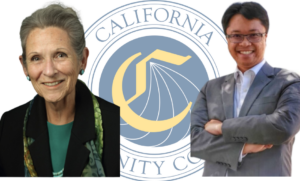 ates for nearly 2 million students at 116 colleges across the state.
ates for nearly 2 million students at 116 colleges across the state.
They will be working with systemwide Chancellor Sonya Christian, who served on the CVHEC board when she was a Central Valley higher education leader, to provide guidance and strategic direction to districts and community colleges in California by implementing the Governor’s Roadmap to Success for California Community Colleges.
They will also work with the chancellor to advance the California Community College’s “Vision 2030” action plan which focuses on improving student outcomes while focusing on four strategic areas: guiding field practice, removing barriers, fostering policy reform, and supporting college implementation.
“We are delighted that in addition to Chancellor Christian, the Central Valley can now claim two new members of the California Community Colleges Board of Governors,” said Dr. Benjamín Durán, executive director, of the Central Valley Higher Education Consortium.
“We are especially pleased that these two new BOG members — coming from the north and south regions of our valley — provide the governing board with true representation from throughout our nine-county region,” Durán added. “Please join us in extending a Central Valley congratulations to the two new Board of Governors members.”
Gomez-Heitzeberg, who taught at Porterville College and was an administrator at Bakersfield College, is a lifelong advocate for education who has witnessed firsthand the transformational power of community colleges.
“My experiences in the classroom, as an administrator, and as a trustee have strengthened my advocacy,” said Trustee Gomez-Heitzeberg. “I appreciate the opportunity to represent the Central Valley and look forward to working with my colleagues to bring Vision 2030 to implementation across the State.”
She brings more than 30 years of experience in serving the disinvested rural student populations of Kern County in various roles, including as: a tenured faculty at Porterville College; an interim president and vice president of Instruction at Bakersfield College; a director of Bakersfield College’s Delano Campus; and the associate vice chancellor for Kern CCD Child Development Centers.
Upon her retirement from BC’s administration, Gomez-Heitzeberg was first elected to serve on the Kern CCD Board of Trustees in November 2018.
Kern CCD Board of Trustees President John Corkins noted that the Southern San Joaquin Valley had been lacking representation on the Board of Governors for a long time.
“Trustee Gomez-Heitzeberg has a deep understanding of what our students here in the Central Valley need to be successful,” Corkins said. “Through her appointment to this important governing body, she will be a tireless advocate for Central Valley students and a voice for higher education in the Valley up in Sacramento.”
Former Kern CCD Chancellor, Tom Burke has worked with Trustee Gomez-Heitzeberg in a variety of roles over the last 25 years.
“Her extensive experience working to provide higher education opportunities for students in the San Joaquin Valley will serve the Valley well as she joins the Board of Governors as the only representative from the Southern Central Valley,” said Burke who is now a regional coordinator for CVHEC helping lead its Kern Master’s Upskilling Program and Central Valley Transfer Project.
Villavicencio, a Delta College Political Science professor and co-chair of the Department of Political Science who will assume one of two faculty seats on the board, said he is “deeply humbled” by the Governor’s appointment.
“I will help represent and elevate the voices of 1.9 million California community college students, as well as 56,000 of my fellow faculty colleagues,” said Villavicencio who received Delta’s Distinguished Faculty Award in 2020.
“While our system faces many challenges from artificial intelligence to closing equity gaps among our underserved and disproportionately impacted students, I know there are many opportunities to improve our system and the lives of our students.”
Dr. Villavicencio has over 18 years of experience in higher education and has been active in local, state, and national politics, including serving as a staffer for the California Asian American Pacific Islander Legislative Caucus in the state Capital. He was elected twice as a delegate to the Democratic National Convention in support of former President Barack Obama in 2008 and 2012.
“We are so very proud of Dr. Villavicencio and his commitment to serve the entire community college system in California,” said Delta College Superintendent/President Dr. Lisa Aguilera Lawrenson, a CVHEC board member.
“The fact that he was selected to represent professors from all over the state speaks to the high quality of our Delta College faculty and their determination to help students succeed,” President Lawrenson added.
The Board of Governors of the California Community Colleges was established in 1967 to provide statewide leadership to California’s 73 community college districts, which operate 116 community colleges.
The Board has 18 voting members as specified in statute. Twelve members are appointed by the Governor, require Senate approval for six-year terms, and must include two current or former local board members. Five members are appointed by the Governor to two-year terms and include two students, two faculty members, and one classified member. The lieutenant governor also serves as a member of the Board.
###
See:
Announcement from the California Community College Chancellor’s Office
Announcement from Gov. Newsom’s office
Kern press release [checking with KCCD PIO to see if they will post it. If not, we can post the pdf)

